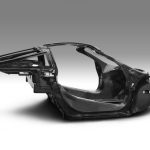McLaren, hallowed hypercar manufacturer and creator of the almighty McLaren F1, has made one hell of a resurgence in the past 6 years. The MP4-12C launched in 2011 as the first new fully McLaren-engineered vehicle in 13 years, and would be the first of many including the 570S, and the hybrid P1. The 12C itself evolved with time, blossoming into the 650S and eventually the 675LT – forming the McLaren Super Series line of vehicles.
But now, it’s time for a new generation of McLaren Super Series. Now, it’s time for the McLaren 720S.
As the numerical portion of the name would suggest, the new McLaren 720S has a power output of 720PS, or in metric terms, 530 glorious kW. That’s matched by a torque output of an absolutely mega 770Nm – all of which coming from an all-new twin-turbo 4.0-litre V8, codenamed M480T. It’s not all new, but rather an evolution of the old 3.8-litre unit, but it features 41% new parts.
On the chassis front, the new carbon fibre “Monocage II” architecture forms the basis of the McLaren 720S, ensuring light weight and immense rigidity. Just how light? Well the McLaren 720S boasts a dry weight of 1283kg – a weight loss of 18kg vs a comparable 650S. It’s not much, but the weight loss combined with extra power contributes to a power-to-weight ratio of 412kW/tonne.
The results speak for themselves in the performance figures of the McLaren 720S. 0-100km/h is swiftly dealt with in a rather brisk 2.9 seconds, 0-200km/h in a frightfully quick 7.8 seconds, all before rushing on to a top speed of 341km/h. Slowing matches the going, the McLaren 720S stopping from 200km/h in 4.6 seconds thanks to 390mm front and 380mm rear carbon ceramic disc brakes housed within 19-inch alloy wheels shod in 245/35 and 305/30 profile rubber respectively.
The McLaren 720S looks spectacular. The logo-aping headlights from previous models are gone now, with a low, broad fascia housing gaping air inlets and headlight clusters integrating brake cooling ducts.
The McLaren 720S features dihedral doors, like the 650S and 12C before it. But, there are no radiator ducts behind the doors – instead, the doors have been moulded to actively direct air into high-temperature radiators for the 4.0-litre V8.
The rear of the McLaren 720S features a design language far cleaner than anything we’ve seen from them before. The active, hydraulically actuated spoiler is now one with the bodywork. It will still act as an airbrake under heavy braking – as with the 650S. Twin tailpipes are mounted high up on the back end, with an aggressive aerodynamic diffuser framing the lower half of the rear.
It’s undoubtedly one of, if not the most beautiful McLaren design to date.
The interior is also a massive step up for McLaren. They’ve reworked the design, but ensured that all finishes remain of the highest quality – fine leathers and machined aluminium – all in a setting that places emphasis on the driver. The highlight of the interior is the McLaren Driver Interface, comprising the Folding Driver Display and Central Infotainment Screen.
The Folding Driver Display is a unique changing driver display system. In default Full Display Mode, the display shows a full range of information on an upright TFT screen linked to the selected driving mode. In Slim Display Mode, selected either manually or automatically when linked to active dynamics functionality, the driver display rotates forwards, exposing the slim fascia displaying only critical information on a narrow strip. McLaren claims this is for enhanced track visibility, or for those who simply admire a more minimalist approach to their instrumentation.
Riding on the back of the highly acclaimed 650S and 675LT models, the 2nd generation McLaren Super Series looks like it could be something incredible. McLaren believe the 720S is something spectacular; in fact they’ve even gone so far as to suggest that the legendary Ayrton Senna would be pleased with it. Don’t believe us? Watch the launch video for the McLaren 720S below. Sounds good, doesn’t it?


















